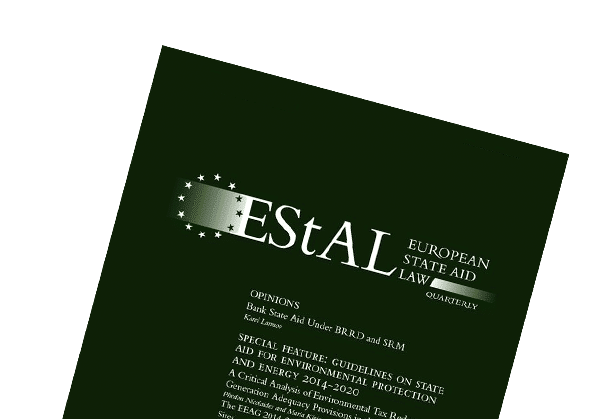
Risk finance measures for the support for large enterprises or SMEs which operate for longer than seven years fall outside the GBER and must be notified individually to the Commission.
Introduction
Since the State aid modernisation and the new rules that were introduced in 2014, only a handful of risk finance measures [7-8?] have been notified to the European Commission for authorisation. One of these measures was an Austrian scheme that provided tax incentives to mid-sized financing companies to increase their funding of SMEs. The Commission approved it in decision SA.45840.[1]
Austria had implemented since 2008 a tax measure to incentivise investments in SMEs – the so-called “MiFiG scheme” [SA.23851]. The measure was in force until December 2018.
The old MiFiG scheme was to be replaced by a new one that was the subject of decision SA.45840. The Commission assessed it on the basis of the Risk Finance Guidelines.
The objective of the new MiFiG scheme was to use favourable tax treatment to encourage investment in start-ups and innovative SMEs in their growth phase. According to Austria, its market was characterised by an “overreliance on banking credit, the absence of large pension funds and a lack of equity raising tradition on the Austrian exchanges.”
Market failure
A study commissioned by Austria identified a financing gap for young SMEs which spent a relatively large proportion of their budget on R&D [innovative SMEs] and for medium sized enterprises in their growth phase.
“(17) A regression analysis in the study shows that for about 50 000 target undertakings, the Risk Capital Gap per undertaking (around EUR 250 000) is also smaller than the average Private Equity investments, which lie around EUR 800 000.”
That is, the typical amount of funding needed or sought by SMEs was smaller than the typical investment by private equity.
“(18) Furthermore, it is shown that investments increase proportionally to total own funds. A comparison is made to Denmark, which has an EU leading role in Venture Capital with around 40 significant investments by Danish growth funds per year. If this were to be translated to the Austrian economy in proportion to GDP, this would lead to around 50 investments annually.” “(19) The ex-ante study demonstrates that Austria suffers from a lack of equity investments due to a number of historical factors: an overreliance on banking credit, the absence of large pension funds and a traditional lack of equity raising tradition on the Austrian exchanges.” “(20) In addition, a regression analysis demonstrates that although the financing gap decreases somewhat for the older companies in general, this is in particular not the case for innovative SMEs.” “(21) Concretely, the experts argued that existing aid measures already stimulated the total amount invested in early phase companies and innovative undertakings but did not yet give a decisive boost to the Austrian risk capital market, whose size has remained negligible compared to France, Germany, UK, Ireland and Finland.”
These comments in the Commission decision suggest that the existence of a funding gap – which is the sine qua non for a successful notification to the Commission – can be established either by comparing the funding needed by and the funding provided to SMEs or by comparing the development of funding in one country with that in others.
Beneficiary financing companies
MiFiGs are limited liability companies with a minimum capital of EUR 7.5 million. Their sole purpose is to lump together contributions by investors [“participations”] in order to make investments in target undertakings. MiFiGs must have at least five shareholders, with no single shareholder controlling more than 49% of the shares.
MiFiGs follow a diversified investment strategy, in conformity with point 67 of the Risk Finance Guidelines [RFG]. They are not allowed to commit more than 20% of their capital in a single undertaking and may not acquire a majority holding in any undertaking.
Eligible investors
The new MiFiG scheme enables its shareholders [the investors] to reduce their tax liability. The shareholders can be natural persons, business angels or institutional investors.
Because under Austrian tax law, dividends received by corporations are already exempt from corporate income tax, institutional investors do not receive any tax advantage from investing in MiFiGs, nor do they benefit from any other special tax exemption [such as capital gains tax] for the sale of their participations in MiFiGs. That is, investing in MiFiG does not lead to any tax advantages for institutional investors.
Target undertakings and maximum amounts
The targeted undertakings are undertakings in their early phase and innovative SMEs in their growth phase.
Undertakings in their early phase are those that fulfil the criteria of GBER Article 21(5 & 6). Broadly speaking, they are in existence less than seven years.
However, undertakings in their early phase need not be SMEs. If they are not SMEs, they must be either a small mid cap (i.e. having fewer than 500 employees and an annual turnover of less than EUR 100 million or a balance sheet less than EUR 86 million) or an innovative mid cap (having fewer than 1500 employees) whose R&D and innovation costs, as defined by the GBER, represent at least 10% of its total operating costs.
Innovative SMEs in their growth phase have to be in existence less than seven years.
Targeted undertakings may not be listed on stock exchange and must not be in difficulty. They need not have their headquarters or their principal establishment in Austria. MiFiGs may also invest in non-Austrian undertakings.
The total investment amount must not exceed EUR 15 million per undertaking invested in.
Form of aid
Natural persons investing in MiFiGs do not have to pay income tax on 75% of dividend distributed by MiFiGs for amounts up to EUR 15,000 per year. For example, the standard rate of income tax in Austria is 27.5% which for income of EUR 15,000, it means a tax advantage of EUR 4,125.
A special feature of the scheme is that MiFiGs are exempt from corporate income tax on the profit stemming from the sale of their shares undertakings invested in. As noted in the Commission decision, “(38) in principle, under Austrian tax law, this tax would have amounted to 25% of the capital gain. However, at the same time, MiFiGs are required by law to distribute dividends to investors equal to at least the amount of the tax advantage.” In other words, MiFiGs act as channels through which all benefits flow to their shareholders.
Do you know we also publish a journal on State aid?
The European State Aid Law Quarterly is available online and in print, and our subscribers benefit from a reduced price for our events.
Existence of State aid
The scheme was imputable to the state and resulted in loss of tax revenue from the two tax exemptions.
The Commission examined the possible existence of State aid at the level of the investors, the financial intermediary and the target companies invested in.
With respect to aid to investors, the Commission distinguished between private individual investors and professional institutional investors. “(49) Insofar as the tax relief is provided to private investors which do not perform economic activities and therefore do not constitute undertakings within in the meaning of Article 107(1) TFEU (i.e. natural persons), the advantage does not constitute State aid within the meaning of that provision. In that regard, the Commission recalls that where a shareholding only gives rise to the exercise of rights attached to the status of shareholder as well as, if appropriate, the receipt of dividends, which are merely the fruits of the ownership of an asset, the investor will not be considered an undertaking if it does not itself provide goods or services on a market.” [At this point the Commission cited the landmark case C-222/04, Cassa di Risparmio di Firenze, paragraphs 107 to 118 and 125.]
“(50) In contrast, insofar as the tax relief is provided to private investors in MiFiG who are undertakings, it constitutes State aid within the meaning of Article 107(1) TFEU. This is the case where private investors in MiFiGs are business angels or individual venture capital investors, who manage their investments and in that capacity act as undertakings.”
“(51) Second, professional institutional investors can also invest in MiFiGs. Although a dividend tax exemption is a priori tax neutral for such investors, since they are in any event exempt from dividend tax, they get the benefit of the capital gains tax exemption at the SPV level. This improves their return on investment, as they would normally have to pay the capital gain tax if they had invested directly in the target companies.”
Then the Commission found that the scheme was selective because “(52) it only benefits investors in MiFiGs and not in other entities”. It also affected trade because “(53) investors benefitting from it may invest throughout Europe” and distorted competition “(54) in relation to the investors.”
With respect to aid to financial intermediaries, the Commission distinguished between the Special Purpose Vehicle [SPV] [i.e. the MiFiG] and the chosen manager of the SPV.
“(56) By benefiting from a capital gains tax exemption, the SPV obtains a selective advantage, since other investment vehicles that compete with it on the EU capital investment markets are in principle subject to tax. Because of the higher expected post-tax returns – which is what investors focus on – the SPVs will find it easier to attract investors.”
“(57) In order to exclude the advantage at the MiFiG level, Austria has included a requirement in its legislation for the MiFiG to make a profit distribution in the fiscal year subsequent to the capital gain. That profit distribution would at least amount to the tax benefits related to capital gains on the sale of target companies in the previous fiscal year.”
“(58) As a result of this correction, the assets under management in the SPV would mimic the net assets under management in a counterfactual scenario without the capital gains tax exemption, thus precluding any advantage at the intermediary level.”
The reasoning of the Commission at this point is very interesting. The counterfactual scenario was used to establish the existence or not of advantage.
The Commission also concluded that the managers would not obtain any advantage. “(59) The manager’s remuneration by the SPV investors is in line with standard market practice. The State does not interfere in the selection of the management and in defining the remuneration conditions. On that basis, the Commission considers that the remuneration reflects the current market remuneration in comparable situations and therefore does not give rise to an advantage.”
With respect to aid to the target companies, the Commission easily found that “(61) the target undertakings obtain an advantage in that they receive better access to capital than they would have in the absence of the measure. That advantage is selective in nature because only the eligible companies may benefit from the MiFiGs investments. It also has the potential to affect intra-EU trade, since target undertakings that benefit from the scheme may operate on several EU markets.”
“(62) In light of the foregoing, the Commission considers the Scheme to constitute State aid … to professional institutional investors and private investors, in so far as they are undertakings, as well as to the target companies benefitting from the Scheme.”
Compatibility with the internal market
The Commission first noted that the scheme does “(64) not fall within the scope of Article 21 of the GBER, since that provision does not allow granting risk finance aid in the form of fiscal incentives to corporate investors. Moreover, that provision does not cover risk finance aid targeting SMEs that have operated for more than 7 years counting from the date of their first commercial sale.” The compatibility assessment had to be made on the basis of the Risk Finance Guidelines [RFGs].
“(66) Under the RFGs, a series of standard conditions laid down in Section 2 of the guidelines has to be met. In addition, the Commission has to ascertain that the aid is in line with the common assessment principles for risk finance measures laid down in section 3 of the guidelines, to declare it compatible with the internal market.”
The requirements in Section 2 of the RFGs
The Commission checked conformity with the following provisions of the RFGs:
Exclusion of risk finance to companies listed on the official list of a stock exchange or a regulated market [point 22].
Involvement of private investors above a certain minimum level [point 23].
Assumption of appreciable risk by private investors and exclusion of measures where the benefits flow entirely to private investors [point 24].
Exclusion of buy-outs, of companies in difficulty and of companies that have received unrecovered incompatible State aid, and of export related activities [points 25, 26 & 27].
The requirements in Section 3 of the RFGs
These requirements are the common compatibility principles:
(a) contribution to a well-defined objective of common interest;
(b) need for state intervention;
(c) appropriateness of the aid measure;
(d) incentive effect;
(e) proportionality of the aid (aid limited to the minimum);
(f) avoidance of undue negative effects on competition and trade between Member States;
(g) transparency of aid.
On the basis of the information submitted by Austria, the Commission found that the scheme served a genuine public policy objective, that it addressed a market failure and that the aid was appropriate. In particular, “(97) using fiscal measures is an appropriate measure, since it improves the return on investment for investors, thereby incentivising them to increase their investments in venture capital and private equity.”
With respect to the incentive effect of the aid, the Commission considered that “(106) by improving the investment returns for the end investors via tax relief the measures encourage investors to make risk finance investments which they would not have made without the incentives. At the same time, however, the measures still imply that investors are sufficiently exposed to the future performance of their investments, thereby encouraging them to make efforts to find the investments with the best risk/return characteristics.” “(107) Since the measure addresses a market failure and is appropriately designed, the Commission concludes that its incentive effect is respected, in line with Section 3.5 of the RFGs.”
With respect to the proportionality of the aid, given that risk finance does not support identifiable costs, it is not possible to establish that the aid is proportional by ensuring that the amount of aid remains below a percentage of eligible costs. In the case of risk finance, the Commission assesses the proportionality of aid differently.
In this connection, the Commission first noted that “(109) investments made under the scheme, including to innovative SMEs, are made by private investors without any direct participation of public investors. This ensures that all investment decisions are commercially driven by the individual decision of private investors. The Commission also notes that the budget of the Scheme is limited to EUR 50 million per annum in foregone tax revenue … By contrast, as described in recital (17), the study has identified a potential of 50 000 target companies with a theoretical average funding gap of EUR 250 000 per company of which only 145 companies have received venture capital or private equity investments.”
“(110) Second, under the new MiFiG scheme investors have no protection against any downside on the invested amounts and the SPV, while benefiting from the capital gains tax exemption, can also not claim any tax credits on capital losses. Consequently, investors remain sufficiently exposed to the consequences of their investment decisions, which should encourage them to search for the best investment vehicle, which makes investments more efficient.”
“(111) Third, as regards the proportionality requirements of the RFGs for fiscal instruments, the Commission notes that point 149 of the RFGs requires that the “Total investment for each beneficiary undertaking may not exceed the maximum amount fixed by the risk finance provision of the GBER”, i.e. EUR 15 million. … the measure respects this condition and the underlying legal framework, since it contains an explicit reference to this limit.”
“(112) Finally, since the income tax relief to private individuals is limited to income tax on dividends for 75% of dividend distributions by MiFiGs for dividend amounts of up to EUR 15 000 per year (so that the actual benefit is limited to income tax paid on EUR 15 000), the measure satisfies both points 151 and 152 of the RFGs.”
Then the Commission turned its attention to possible undue negative effects on competition and trade between Member States. Its analysis was short. “(115) The measure targets a well-defined market failure, which substantially reduces the risk of crowding out.”
On the basis of the above findings, its overall conclusion was that the aid was compatible with the internal market.
———————————————
[1] The full text of the Commission decision can be accessed: https://ec.europa.eu/competition/state_aid/cases1/201939/281203_2096943_109_2.pdf.



